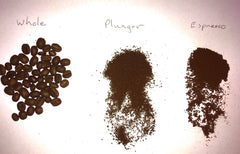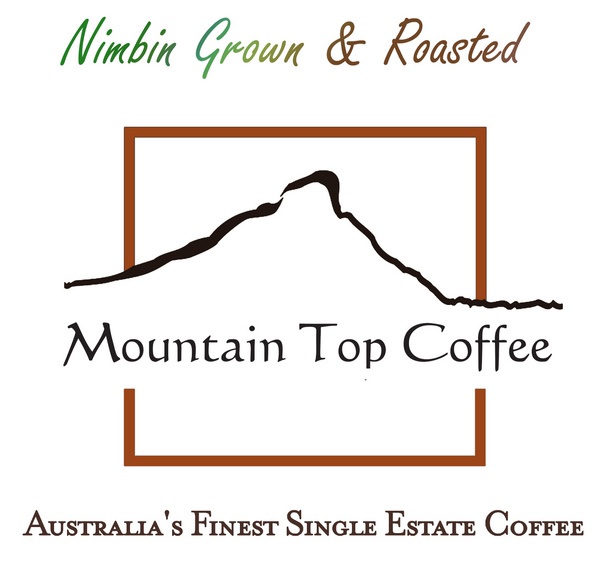
Brewing and Grinding Coffee
Share
Brewing and Grinding Coffee
The art of brewing and grinding coffee has a mystery to it that should not be unpacked too much. This blog is intended to discuss the two fundamental principles behind every brew - extraction, and filtration. The following is not just specific to Mountain Top coffee. Due to our conditions and the nature of the varietal we produce, Mt Top Coffee is what is called a dense coffee*, meaning it holds integrity due to its cellular structure. That, plus the added advantage that it is inherently smooth, means it is hard to mess up when brewing.
The key to brewing is extraction, and the key to good extraction is filtering.
I have taken whole roasted beans and placed them in a sealed jar in clean water and left it in the fridge for over a week. In that time the coffee extracted virtually all it needed to extract without detriment. Indeed, its unique flavours were enhanced in many ways whilst other, less savoury and harsh flavours that can be incurred via hot water extraction, were absent.
Grinding coffee is a necessity for expedient extraction, but it can alter flavours detrimentally. The other expedient is heat. The method of extracting using cold water, without grinding the bean at all, works because the bean acts as its own filter - the ultimate filter – whilst cold water does not produce some of the nasties that hot water can. Particles that escape into the cup from whatever brewing method you use: espresso, plunger, stovetop, pour-over, etcetera, will continue to extract in the cup, even as it cools. That is why a cup of coffee can taste bitter or sour after only 10 minutes left to sit alone after brewing. Fine particles are the main culprits. The addition of heat when extracting produces some great flavours that cold brewing cannot. This is due mainly to the breakdown of oils into flavours and aromas, though a long extraction time in cold water will go some way to the same end. It is universally recognised that cooler extractions bring out flavours unique to specialty coffees. Play with extractions between 0 and 100 degrees Celsius of the same grind to explore this for yourself.
It stands to reason then that the coarser the grind the less chance there is for things to go wrong, and for a cup of coffee to wait there for you on the bench and still be delicious when it's cooled down.
As given in the recipe above, one trick is to further filter a plunger coffee that has just brewed through a paper filter to make sure the cup is free of the sludge that spoils. The common device used, as pictured, is the V60 conical filters, but a clean piece of fine cloth can work too.
My talk of whole bean extraction in this blog is mainly for didactic purposes, I am not expounding whole bean extraction as the optimum way to brew coffee. Indeed, Mt Top Coffee has been said to best suit the espresso method.
You can research easily what grinds are needed for specific brewing methods. Mountain Top Coffees, as stated earlier, are generally very dense yet smooth coffees. You can really hammer them hard on an espresso machine or, with practice, leave them to extract for longer than the usual 2-4 minutes in a plunger without deleterious results and get deeper, richer goodies.
One last thing with grinding is that as soon as you grind the shelf life decreases quantifiably. In general, the shelf life of exposed to air ground roasted bean will decrease in 20 minutes at a rate the same as one day of exposed whole roasted bean will.... the finer the grind the more amplified the degradation.

I may have missed a few obvious things here, so please feel free to ask questions.
*There is a nice blog here for those who want to go deeper into what dense coffee is: https://www.torchcoffee.asia/blog-1/2018/7/9/why-does-density-matter-and-what-affects-the-density-of-coffee
Until next time, Bernie.

3 comments
Hi Alex. I am so sorry not to see this comment (or others) earlier. My bad. I hope you get this reply. Great comment and questions. I have posted a great scientific link to an article on TDS (total dissolved solids) below. Yes, that balance in roasting is the holy grail of roasting, yet most customers prefer at least a little dark (whether this is conditioned behaviour or not is another discussion). Carbonisation begins before one can do much about it. It murders chocolate notes yet it almost goes hand in hand with caramelisation – the chemical reaction that transforms sugars within the flavour compounds one is trying to preserve or accentuate. I think I can agree with you about the difference in water temp necessary between light and dark roasts. Another critical thing to my mind is extraction time, generally though keeping the temp down is most ideal and increasing extraction time can help offset lower temp. Have you tried not grinding and extracting whole beans in a jar? It really is a good way to learn and observe extraction. Try 40grams in 600ml, check and test twice a day. Thanks again for comment and do reply if you like. Cheers, Bernie
https://www.ncbi.nlm.nih.gov/pmc/articles/PMC6560105/
Great information and links, well informed and educational instruction, further indemnifying my reasoning for choosing Mountain Top Coffee.
Bernie, another great article. I’ve never really done cold brew before, so it’s good to be given encouragement like this to try it. Just wondering what ratio of water (ml) to coffee (g)?
Something I’ve discovered recently is that lighter roasts require higher temperatures, whereas darker roasts don’t as much. I assume this is because the roasting process creates flavour while also reducing compounds and making extraction easier, so one of the difficult things I find with brewing with Hario V60 is finding adequate medium roast coffee. Any dark roast coffee doesn’t taste good at all, but light roast is too difficult to extract flavour from, even with near-boiling water. It has to be roasted just right, without being burnt at all.
The ratio of grams to brew output varies depending on the coffee, but lately I’ve been getting 600ml from 40g of coffee. It’s drinkable without requiring further dilution, but tastes sufficiently strong enough to provide a satisfying experience. Since I’ve never really tried cold brew that much, I wonder if it’s both satisfying and economical enough to be worth the process.
When I grind at the coarsest setting with my current grinder, it tastes alright, but it’s much more satisfying a few notches finer, but anything further tastes too muddy with my current brew method.